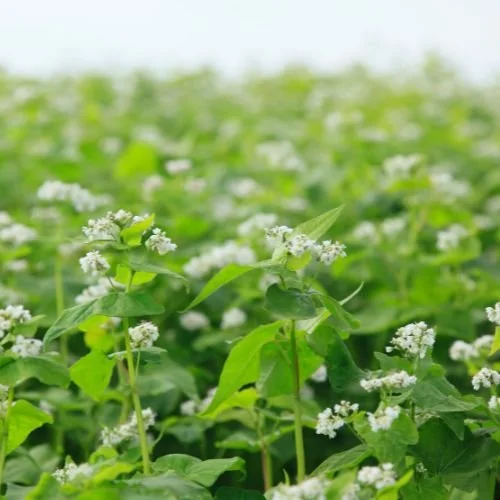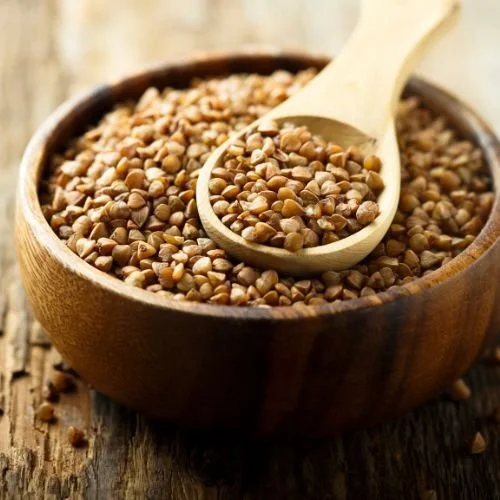

Organic buckwheat seeds
Buckwheat (Fagopyrum esculentum)
Buckwheat is a quick-growing, versatile "pseudo-cereal" that's gaining popularity for its benefits as a cover crop and as a naturally gluten-free flour. Despite its name, it's not a true grain but a fruit seed related to rhubarb and sorrel.
Cover Plant Benefits:
Rapid Establishment and Weed Suppression: Buckwheat germinates quickly (3-5 days) and forms a dense canopy within weeks, effectively shading out and smothering warm-season annual weeds. This makes it an excellent "smother crop."
Soil Health Improvement:
Nutrient Scavenger: It's particularly effective at taking up phosphorus and other minor nutrients (like calcium) that might be unavailable to other plants, releasing them back into the soil as its residue breaks down. Its roots also exude mild acids that help solubilize nutrients.
Soil Conditioner: Its abundant, fine root system leaves the topsoil loose and friable, improving soil structure, aeration, and water infiltration.
Organic Matter: Contributes significant organic matter to the soil as it decomposes rapidly.
Pollinator Magnet: Buckwheat's numerous white, fragrant blossoms are a superb nectar and pollen source, especially during late summer when other forage might be scarce. It attracts a wide array of pollinators, including honeybees, native bees, bumblebees, hoverflies, and predatory wasps, which in turn help control garden pests.
Emergency Crop: Can be planted as a quick cover to protect soil and suppress weeds if a main crop fails or cannot be planted due to unfavorable conditions.
Nurse Crop: Can be planted with slower-growing cover crops, like legumes, to provide initial weed suppression until the slower crop establishes.
Naturally Gluten-Free Flour: Buckwheat is naturally gluten-free, making it an excellent alternative for individuals with gluten sensitivities or celiac disease. It's often used in:
Baked Goods: Adds a distinct earthy, nutty, and slightly bitter flavor to pancakes, crepes (like French galettes or Russian blini), noodles (Japanese soba), and various baked goods. It can be used in combination with other gluten-free flours to achieve desired textures.
Nutritional Powerhouse: Compared to common gluten-free flours like rice and maize, buckwheat flour is exceptionally nutritious. It's rich in:
Protein: Contains a high amount of quality protein with a well-balanced amino acid profile, including lysine and arginine, which are often limited in plant foods.
Fiber: High in dietary fiber, particularly insoluble fiber, which aids digestion and promotes gut health. It also contains resistant starch, beneficial for colon health.
Vitamins and Minerals: A good source of B vitamins (niacin, riboflavin, folate), and essential minerals like magnesium, phosphorus, iron, copper, manganese, and zinc.
Antioxidants: Rich in antioxidants such as rutin, quercetin, and vitexin, which contribute to its potential health benefits.
Health Benefits: Beyond its value as a cover crop and a food source, buckwheat offers several health advantages:
Blood Sugar Control: Its unique soluble carbs, like fagopyritol and D-chiro-inositol, can help moderate blood sugar levels after meals, making it beneficial for individuals with type 2 diabetes or those seeking to manage blood sugar.
Heart Health: The combination of rutin, magnesium, copper, fiber, and specific proteins in buckwheat may contribute to improved heart health by lowering blood pressure and cholesterol levels.
Digestive Health: Its high fiber content supports efficient digestion, helps prevent constipation, and may reduce the risk of diverticular disease.
Weight Management: Being high in protein and fiber, buckwheat can promote a feeling of fullness (satiety), which can aid in weight management by potentially reducing overall calorie intake.
Planting Instructions
When to Plant: Buckwheat is a warm-season annual and is frost-sensitive. Plant after all danger of spring frost has passed, typically in late spring or early summer. It's commonly used as a mid-summer cover crop.
Soil: Thrives in well-drained, light to medium soils (sandy loams, loams, silt loams). Tolerates poor fertility and acidic soils but dislikes shade, compacted, or excessively wet conditions.
Sowing:
Buckwheat needs 3-4 days of complete darkness in order to germinate! Sprinkle seeds over soil in a shallow container that can be covered, make sure the soil is moist and place the entire thing in a cupboard, drawer, or any place that can offer total darkness for 3-4 days.
Growth Cycle: Germinates in 3-5 days. Flowers begin in as little as 4 weeks. For cover crop benefits (weed suppression, organic matter), terminate (mow or lightly till) before seeds fully mature (typically 6-8 weeks after planting or when 25% of flowers are in bloom) to prevent unwanted self-seeding. If growing for grain, it matures in 70-90 days.
Nutrient Release: Buckwheat residue decomposes quickly, releasing nutrients for subsequent crops. If tilling, allow a week or two for decomposition before planting the next crop. For no-till, leave residue on the surface.
Buckwheat (Fagopyrum esculentum)
Buckwheat is a quick-growing, versatile "pseudo-cereal" that's gaining popularity for its benefits as a cover crop and as a naturally gluten-free flour. Despite its name, it's not a true grain but a fruit seed related to rhubarb and sorrel.
Cover Plant Benefits:
Rapid Establishment and Weed Suppression: Buckwheat germinates quickly (3-5 days) and forms a dense canopy within weeks, effectively shading out and smothering warm-season annual weeds. This makes it an excellent "smother crop."
Soil Health Improvement:
Nutrient Scavenger: It's particularly effective at taking up phosphorus and other minor nutrients (like calcium) that might be unavailable to other plants, releasing them back into the soil as its residue breaks down. Its roots also exude mild acids that help solubilize nutrients.
Soil Conditioner: Its abundant, fine root system leaves the topsoil loose and friable, improving soil structure, aeration, and water infiltration.
Organic Matter: Contributes significant organic matter to the soil as it decomposes rapidly.
Pollinator Magnet: Buckwheat's numerous white, fragrant blossoms are a superb nectar and pollen source, especially during late summer when other forage might be scarce. It attracts a wide array of pollinators, including honeybees, native bees, bumblebees, hoverflies, and predatory wasps, which in turn help control garden pests.
Emergency Crop: Can be planted as a quick cover to protect soil and suppress weeds if a main crop fails or cannot be planted due to unfavorable conditions.
Nurse Crop: Can be planted with slower-growing cover crops, like legumes, to provide initial weed suppression until the slower crop establishes.
Naturally Gluten-Free Flour: Buckwheat is naturally gluten-free, making it an excellent alternative for individuals with gluten sensitivities or celiac disease. It's often used in:
Baked Goods: Adds a distinct earthy, nutty, and slightly bitter flavor to pancakes, crepes (like French galettes or Russian blini), noodles (Japanese soba), and various baked goods. It can be used in combination with other gluten-free flours to achieve desired textures.
Nutritional Powerhouse: Compared to common gluten-free flours like rice and maize, buckwheat flour is exceptionally nutritious. It's rich in:
Protein: Contains a high amount of quality protein with a well-balanced amino acid profile, including lysine and arginine, which are often limited in plant foods.
Fiber: High in dietary fiber, particularly insoluble fiber, which aids digestion and promotes gut health. It also contains resistant starch, beneficial for colon health.
Vitamins and Minerals: A good source of B vitamins (niacin, riboflavin, folate), and essential minerals like magnesium, phosphorus, iron, copper, manganese, and zinc.
Antioxidants: Rich in antioxidants such as rutin, quercetin, and vitexin, which contribute to its potential health benefits.
Health Benefits: Beyond its value as a cover crop and a food source, buckwheat offers several health advantages:
Blood Sugar Control: Its unique soluble carbs, like fagopyritol and D-chiro-inositol, can help moderate blood sugar levels after meals, making it beneficial for individuals with type 2 diabetes or those seeking to manage blood sugar.
Heart Health: The combination of rutin, magnesium, copper, fiber, and specific proteins in buckwheat may contribute to improved heart health by lowering blood pressure and cholesterol levels.
Digestive Health: Its high fiber content supports efficient digestion, helps prevent constipation, and may reduce the risk of diverticular disease.
Weight Management: Being high in protein and fiber, buckwheat can promote a feeling of fullness (satiety), which can aid in weight management by potentially reducing overall calorie intake.
Planting Instructions
When to Plant: Buckwheat is a warm-season annual and is frost-sensitive. Plant after all danger of spring frost has passed, typically in late spring or early summer. It's commonly used as a mid-summer cover crop.
Soil: Thrives in well-drained, light to medium soils (sandy loams, loams, silt loams). Tolerates poor fertility and acidic soils but dislikes shade, compacted, or excessively wet conditions.
Sowing:
Buckwheat needs 3-4 days of complete darkness in order to germinate! Sprinkle seeds over soil in a shallow container that can be covered, make sure the soil is moist and place the entire thing in a cupboard, drawer, or any place that can offer total darkness for 3-4 days.
Growth Cycle: Germinates in 3-5 days. Flowers begin in as little as 4 weeks. For cover crop benefits (weed suppression, organic matter), terminate (mow or lightly till) before seeds fully mature (typically 6-8 weeks after planting or when 25% of flowers are in bloom) to prevent unwanted self-seeding. If growing for grain, it matures in 70-90 days.
Nutrient Release: Buckwheat residue decomposes quickly, releasing nutrients for subsequent crops. If tilling, allow a week or two for decomposition before planting the next crop. For no-till, leave residue on the surface.